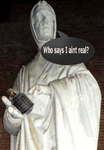Ok, Tony, time to cut your blatant ramble..........first, if there is an original ratio then WHO came up with it, if not Leonardo Pisano Fibonacci? Is the statue that is erected in his name a fake pose? Who invented the supposed fable? How are you going to prove this ? I mean, by what process are you going to prove, to us, that this persons history is ficticious? Display to us how the ratios "fall flat" .
That the 50% ratio is not part of the sequence, is probably the only part you have correct so far.
I am keen to hear your lucid and indepth reply.
http://faculty.evansville.edu/ck6/bstud/fibo.html (a part picture of his statue)
Joules
Joules, you do love to joust with the big boys don't you.
😆
To use your link as a first port of call allow me to quote from it so there is no question of my being selective,
"Unfortunately, not much is known about Fibonacci's personal life". In fact, there are no contemporary references to this man. But then there aren't for Jesus of Nazareth either.
"No portraits of Fibonacci exist. Possibly, the imaginative description of the education, clothes and housing of people of medieval Pisa, as given in [4], was applicable to Fibonacci. " Possibly indeed. I guess the statue you refer to is an artist's impression.
😆
"According to some writers, a mathematical tournament between Fibonacci and other mathematicians took place, but this does not seem to have been the case". Yep. All references to the Rabbit problem and the maths games all relate back to a single source. None of which have any contemporary support or reference.
"The last we hear of Fibonacci is in a document issued by the commune of Pisa in 1240. This granted an annual honorarium of 20 Pisan pounds, plus expenses, for community services to "the discreet and learned man, Master Leonardo" [4].
No one knows when Fibonacci died nor under what circumstances his death occurred."
And
"What did Fibonacci look like? Did Fibonacci marry? Did he have any children? What was the state of his health? his wealth? What were his political views? To what extent, if at all, did he rely on the works of the Greeks (e.g. the (now) lost books of Diophantus)? It is a great pity indeed that we do not know more about this remarkable man." Absolutely. In fact, what we do know is actually quite sparse. You'd have to pay big bucks to get an id wipe that good these days.
So rather than throw down the gauntlet and suggest I prove he didn't exist (let's keep Black Swans out of this for now, but you know exactly what I mean), I'm going to suggest you find contemporary references they prove he did. And can I suggest you check your research more thoroughly before providing any further 'support' for your case as your last one has you clearly looking a little surprised at the smoking gun in your hand the hole in your foot.
😱
